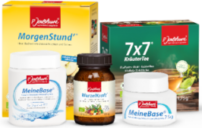Milk and Osteoporosis by Dr. h.c. Jentschura
Posted on : 05-10-2011 | By : Stephan, The Alkaline Diet Guy | In : Uncategorized
2
Milk and osteoporosis
Did you know that women in Korea do not suffer from Osteoporosis? Why? Simply because they do not drink milk!
Oftentimes milk is recommended for the supply with calcium when suffering from mineral supplement deficiency diseases like osteoporosis. But by now it is known that the reason for this disease is not an insufficient intake of calcium and much less an insufficient consumption of milk but rather a highly overacidic nutrition and lifestyle. This robs the organism of minerals and harms the bones.
If milk was as indispensable for the health of our bones as oftentimes considered the countries with the lowest consumption of milk like e. g. countries in Asia and Africa, should have the highest rates of osteoporosis. This is not the case. Indigenous people who consume no milk at all have an outstanding bone density.
The large quantities of milk protein that are consumed nowadays are problematic for our organism. The exogenous lactoprotein is reabsorbed by the intestine into the blood but not incorporated into the cells. Thus the blood gets overloaded with milk protein. This condition can be made visible on blood pictures with the dark-field microscope. Furthermore our cleansing system, the lymph is being constipated and congested.
Milk and intolerance
In the field of adverse reactions to food you differentiate between allergies and intolerances or non-allergic hypersensitivities. If a person suffers from an allergy against a special type of food the immune system of that person answers towards the food or a special constituent with an antigen- and antibody-specific reaction. Symptoms appear only after multiple contacts with the allergen.
One special food allergy is the allergy against cow’s milk protein. The sources are allergenic proteins like e. g. casein or whey proteins. Symptoms of an allergy against cow’s milk protein are diarrhoea and vomiting but also skin and airway problems like e. g. asthma. These symptoms are not related to the quantity of allergen that was taken in. People suffering from this allergy have to avoid contact with the respective allergens, i. e. the relevant dairy products by all means.
If suffering from an intolerance or hypersensitivity the reaction is triggered directly by the constituents of the food. There is no antigen- and antibody-specific reaction. When the enzyme lactase looses its ability and activity to
segregate milk sugar the undigested lactose finds its way into the lower parts of the intestine. Among others, this process can lead to flatulence, abdominal pain and diarrhoea. The symptoms often appear several hours after first contact with the respective substance. One example for these intolerances is lactose intolerance.
Roughly 15 % of Germans develop this intolerance against lactose at some point of their lives. Among other population groups in e. g. Africa or Asia lactose intolerance is even more common.
Usually fermented milk products like yoghurt, kefir and buttermilk are tolerated by people with lactose intolerance at least in small quantities. This is because during the preparation of yoghurt special lactic acid bacteria are mixed into the milk that prepare the way by transforming the lactose into lactic acid.
During infancy and toddler age cow’s milk and dairy products are considered to be the most common triggers for intolerances. Symptoms can for example be diarrhoea and infantile eczema or even atopic dermatitis. Particularly for atopic dermatitis it is recommended to abandon the consumption of milk and dairy products. Oftentimes the condition quickly improves. Toddlers should take in dairy products not until after 12 months
We recommend:
1 Avoid milk, sugar, gluten, meat products and eat lots of greens. Dr. Jentschura’s omni-molecular life food WurzelKraft has 106 herbs and offers all vital substances, minerals and vitamin to help the kidneys work!
2 Long full or foot bath help to detox the body via the skin. You use AlkaBath with 8 precious stones. Also you can do Alkaline Wraps and Stocking and help your body detox with dry and wet brushing.
3 Regenerate with Oxygen treatments: Take 3 drops of Hydrogen Peroxide on half a glass of water 3 times a day (10.00 am, 4.00 pm and 9.00 pm) on an empty stomach and do not eat for 30 min. This is a strong cleanser and it helps your body with the absorption of nutrition. Also Drink one tea spoon of Baking Soda in a glass of water before you go to bed at 10.00 p.m. to help you alkalize during the night.






What grade of hydrogen peroxide should be used for the oxygen treatment taken internally?
Hi,
3 drops of 3% on a glass of water 3 times a day at 10 a.m, 4.00 pm and 10 pm.
External use is great: 100 ml of 3 % plus 100 ml of destilled water in a spray bottle and spray on your body as much as you can/like. Kindly, Stephan